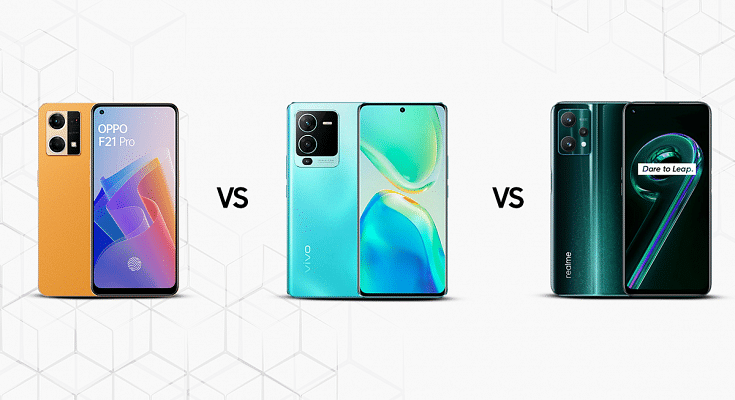OPPO F21s Pro and the Vivo V25 are the new entrants in the mid-range market. Both of these phones are now competing for a slot in this segment alongside the Realme 9 Pro. All three phones include triple-back cameras, fast battery charging, and compelling looks in their own way.
Therefore, it should go without saying that a thorough comparison of these three phones was necessary. Here, we outline the OPPO, Vivo, and Realme phones you should think about purchasing in the sub-Rs. 30,000 price range.
Design And Display
The OPPO F21s Pro comes with orbit light around the camera. It has a glossy plastic finish and a back with a thin retro design at the back that could easily become a fingerprint magnet. It features a 6.43-inch AMOLED screen with full HD+ resolution and a 60Hz refresh rate.
The Vivo V25, on the other hand, has a back panel made of Anti-Glare glass, which can change color when sunshine or UV rays strike it. With a 6.44-inch AMOLED screen and a 90Hz refresh rate, the phone’s display offers Full HD+ resolution.
Moving to the Realme 9 Pro, the phone boasts a 6.60-inch Super AMOLED display with support for Full HD+ resolution at 1080 × 2400 pixels. The phone comes with a 120 Hz refresh rate. The screen of the device has a punch-hole design that houses the front camera.
Performance
Snapdragon 695 is the processor used by the OPPO F21s Pro. The smartphone has 8GB of RAM and 128GB of internal storage. The operating system for the F21s Pro is ColorOS 12.1 which is based on Android 12.
If we talk about the Vivo V25, the MediaTek Dimensity 900 SoC is the chip that drives the Vivo V25. Up to 12GB of RAM and 256GB are available in this device. Additionally, you have the option to virtually increase the RAM to 8GB. The device uses Android 12-based Funtouch OS 12 out of the box.
Besides, Realme has used an octa-core Qualcomm Snapdragon 695 processor to power the 9 Pro device. The phone comes paired with either 6GB or 8GB RAM and 128GB internal memory that is further expandable. The phone runs on Realme UI 3.0 based on Android 12.
Cameras
The triple rear camera system on the OPPO F21s Pro includes a 64MP primary sensor, a 2MP depth sensor, and a 2MP macro sensor. Up front, the device has a 16MP selfie camera.
The Vivo V25, on the other hand, has three cameras on the back: a 2MP macro camera, an 8MP ultra-wide sensor, and a 64MP primary sensor with optical image stabilization. The V25 boasts a massive 50MP front camera with eye AF for selfies.
The Realme 9 Pro comes with a quad rear camera that consists of a 64MP primary sensor, 8MP ultra-wide-angle sensor, and 2MP sensor. On the front, you get a 16MP selfie camera to click selfies and video calls.
Battery
While the OPPO F21s Pro has a 4,500mAh battery that supports 33W fast charging out of the box, the Vivo V25 packs a 4,500mAh battery and supports 44W fast charging. Moving to the Realme 9 Pro, the phone houses a 5,000mAh battery that supports fast charging via a USB Type C port.
Verdict
OPPO F21s Pro is another mid-range phone that tries to differentiate with its color-changing design. The display of all three phones is pretty much the same, except for the 120Hz refresh rate support from Realme. OPPO and Realme are using the same chipset to power the phone, which has been an effective option in this price range.
The cameras aren’t too dissimilar either, but Vivo clearly takes the crown with its 50MP selfie camera. Realme 9 Pro gives you a bigger and more long-lasting battery than the other two.
